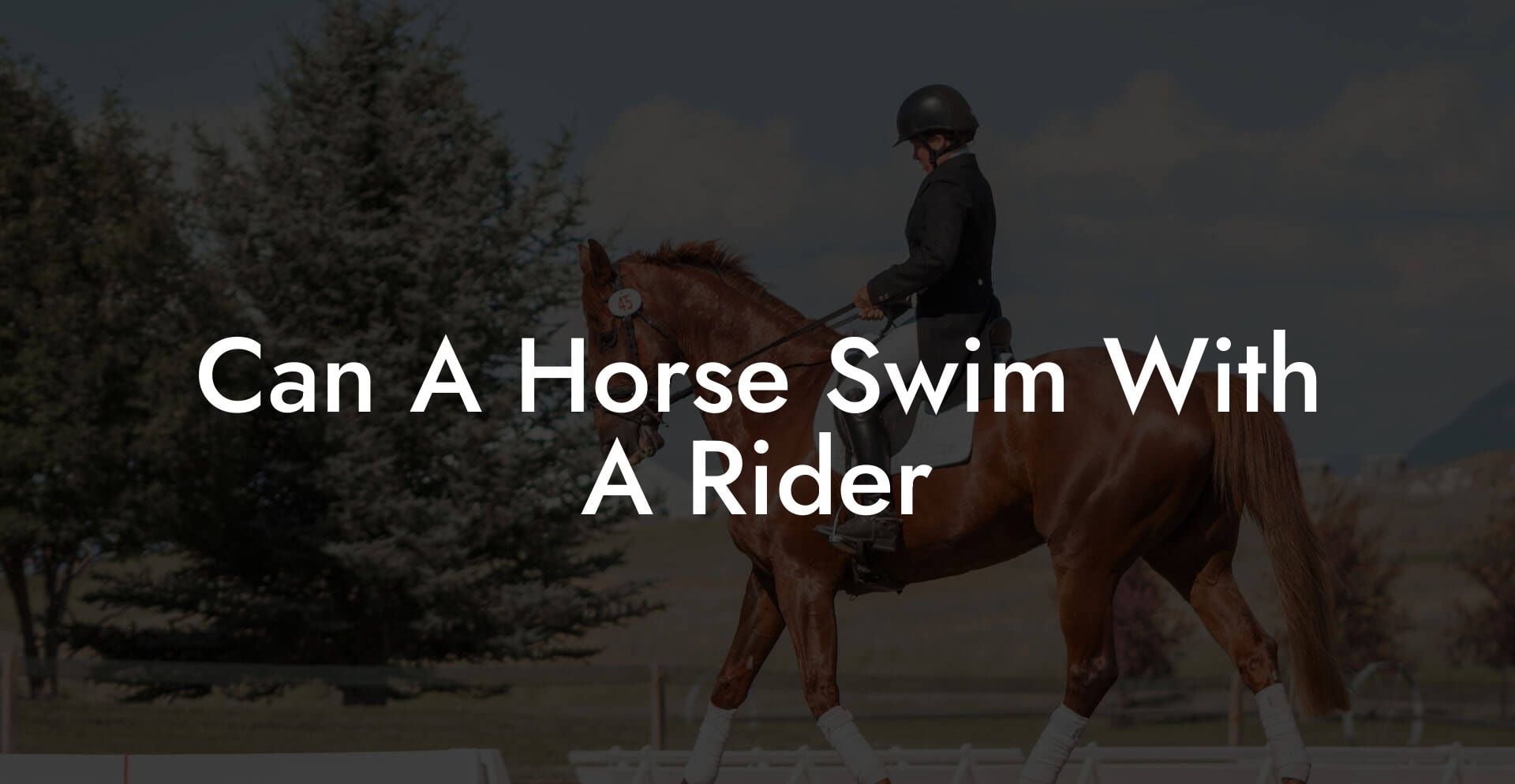Ever wondered if your majestic steed can turn into a playful water acrobat with you perched on its back? If you’ve ever caught yourself daydreaming about splashing around with your horse, then you’re in the right place. riding into the waves isn’t just a quirky idea from a bygone era of cowboy movies, it’s a real activity combining adventure, exercise, and a unique bonding experience between horse and rider. Dive in as we explore the ins and outs, safety tips, training techniques, and downright fun facts about horse swimming with a rider.
Quick Links to Useful Sections
- The Natural Swimmers: Horses in Their Element
- Can a Horse Swim With a Rider? Breaking Down the Basics
- The Science Behind Equine Aquatics: How Horses Stay Afloat
- Training Techniques: Preparing Your Horse for Aquatic Adventures
- Getting Started: Introduce the Water Gradually
- Progressing to Deeper Waters
- Introducing the Rider
- Involving Professional Guidance
- Swimming with a Rider: Balancing Safety and Adventure
- Rider Safety First
- Horse Health and Readiness
- Establishing a Safe Communication Protocol
- Diving Into Benefits: Why Horse Swimming is More Than Just a Novelty
- Enhanced Cardiovascular Fitness
- Joint and Muscle Relief
- Stress Reduction and Mental Well-being
- A Bonding Experience Like No Other
- Essential Gear and Safety Tips for a Splashtastic Ride
- For the Rider
- For the Horse
- General Safety Measures
- Common Myths About Horse Swimming, Busted!
- Myth 1: Horses Don’t Like Water
- Myth 2: Riding in Water is Always Risky for the Horse
- Myth 3: Only Expert Riders Should Try This
- Myth 4: It’s Bad for the Rider’s Balance
- Integrating Horse Swimming into Your Equestrian Routine
- Scheduling Your Sessions
- Complementary Training Methods
- Tracking Progress
- Rider’s Guide: Techniques for a Smooth Aquatic Experience
- Adapting Your Seat
- Using the Reins Wisely
- Working on Core Strength
- Resources and Community Support: Your Next Steps
- The Future of Aquatic Equestrian Adventures
- Frequently Asked Questions About Horse Swimming
- Your Journey to Equine Aquatic Mastery
The Natural Swimmers: Horses in Their Element
Horses have been known to take an unexpected dip in the water since time immemorial. Despite their powerful build and heavy frames, many equines are surprisingly adept at swimming. In the wild, horses instinctively paddle to cross rivers or escape predators, showcasing a natural prowess for water navigation. Their long legs, buoyant bodies, and instinct-driven paddling technique give them an edge when it comes to staying afloat.
While not every horse may spontaneously advertise its love for the water, a significant number of our equine friends display a comfort level in aquatic escapades that can rival even the best swimmers in the animal kingdom. The secret lies in evolution, horses have been crossing water bodies for ages, which means their bodies are built to handle a splash or two.
Now, let’s elevate the scenario: imagine coupling that natural aquatic ability with the presence of a rider. The concept of horse swimming with a rider might leave some enthusiasts with raised eyebrows and others brimming with excitement. It’s a world where equestrian tradition meets aquatic adventure, and where the connection between animal and human takes on an entirely new dynamic.
Can a Horse Swim With a Rider? Breaking Down the Basics
At its core, the question “Can a horse swim with a rider?” might seem straightforward, yes, in most cases they can. However, the nuances of making this possible safely are where things get both interesting and a bit technical. The answer isn’t an unqualified “yes,” but a well-informed, context-dependent “yes, under the right conditions, with proper training and safety measures.”
Horses are biologically capable of swimming with a rider, but whether they should depends on a few critical factors: the horse’s health, the rider’s skill, the water conditions, and the purpose behind the swim. For hobbyists looking to add a splash of variety to their routine, water workouts for horses and riders can offer a low-impact, high-fun activity. For competitive or therapeutic purposes, it can also be a way to build strength and improve joint mobility for both.
In many equestrian circles, swimming is integrated into a horse’s overall training regimen. For instance, many trainers use water workouts as part of conditioning programs to reduce the strain on joints while still providing vigorous exercise. And yes, having a rider in the mix can elevate the challenge, and the fun factor, even further.
The Science Behind Equine Aquatics: How Horses Stay Afloat
You might wonder, “How does it work?” When submerged, a horse’s body relies on several physical principles to keep afloat and move through water. Just like us, horses naturally employ a doggy paddle; their coordinated leg movements create a steady, propelling force. Their relatively light bone structure and large lung capacity enhance buoyancy, a trait that is particularly advantageous when the horse is both in water and carrying additional weight.
Here’s a quick breakdown of the mechanics:
- Buoyancy and Body Composition: Horses have a high proportion of muscle and fat distributed in such a way that their bodies naturally float. Their lung capacity is significantly larger than many other animals of similar size, contributing to additional buoyancy.
- Leg Paddling Technique: The rhythmic, alternating kick of a horse’s legs creates forward motion and stabilization. This natural paddling method is instinctive, so adding a rider’s weight doesn’t disrupt the basic motor pattern.
- Adaptive Instincts: Much like dogs or otters, horses adapt to water when necessary. Many horses initially show reluctance but quickly learn from positive aquatic experiences, evolving into confident swimmers.
Combining these factors, we see that the equine body is remarkably well-suited to swimming, transforming any water body into an open playground for a capable horse, particularly with a trusting rider on board.
Training Techniques: Preparing Your Horse for Aquatic Adventures
Before you don your coolest swimwear and grab those waterproof goggles, there’s a crucial step to consider: training. Just like any physical activity involving both animal and human, preparation is vital. The goal is to gradually introduce your horse to water in a controlled, safe environment, ensuring that both of you are comfortable and confident.
Getting Started: Introduce the Water Gradually
The first training step involves familiarizing your horse with the presence of water. Start at the edge of a calm lake or a shallow pond. Let your horse observe and sniff the water, and allow it to become accustomed to the sensation. Patience is key here, never force your horse into a situation that causes overt anxiety.
You can even use appealing, positive reinforcement techniques. Offer treats, soft praises, and gentle touch to make the water a reassuring place. The idea is to gradually build trust within your horse’s natural curiosity.
Progressing to Deeper Waters
Once your horse feels comfortable near the water, you can start introducing it to shallow swimming sessions. Begin with short, supervised swims where the horse is free to paddle while you stay close at the bank. The initial sessions should have no rider, a sort of “water-warming” phase. This helps the horse understand that water isn’t something to fear.
After several successful sessions, you can begin to introduce a lightweight saddle or a specially designed floatation harness. The rider’s role should be minimal at first, offering support and maintaining calm energy. The transition is all about balance, patience, and respecting your horse’s pace.
Introducing the Rider
With your horse acclimated to the water, the next step is adding the rider. Start with a gentle, belly-first approach, allowing the horse to get used to the sensation of someone sitting on its back while swimming. It’s important to keep the initial rides short and rewarding. Gradually, as trust builds and the horse’s confidence grows, you can increase the duration and complexity of the rides.
Incorporate exercises that enhance balance and coordination. For instance, practice basic commands and simple navigational cues, ensuring that both you and the horse are in sync while paddling. Over time, your coordinated efforts will transform the water ride into a dance of mutual trust and athleticism.
Involving Professional Guidance
If you’re new to the world of aquatic equestrian training, consider enlisting a professional trainer with experience in horse swimming. They can offer tailored advice, ensure safety protocols are followed, and help fine-tune techniques that work best for both you and your horse.
Remember, safety should always come first. A gradual, respectful approach to training will make your aquatic adventures both enjoyable and safe.
Swimming with a Rider: Balancing Safety and Adventure
While the prospect of riding your horse through a refreshing body of water is undeniably exhilarating, it comes with its share of safety considerations. Let’s be real: water can be unpredictable, and even the best-trained horse must navigate currents, unexpected depths, and the occasional stray log.
Rider Safety First
Before embarking on any water-based adventure with your horse, you as the rider must prepare too. Wearing a life vest is a non-negotiable safety measure, trust us, even the most experienced equestrians have taken a surprise dive once or twice. Equally important is making sure you’re comfortable and confident in the water yourself. A sudden slip or panic from the rider can unsettle even the calmest horse.
Equip yourself with appropriate riding gear that is resistant to water and quick-drying. Consider investing in waterproof saddles or saddle covers designed specifically for aquatic activities. These not only protect your valuable gear but also keep you comfortable throughout the ride.
Horse Health and Readiness
Just as you prepare, your horse must be in optimal health and match the physical demands of swimming with a rider. Routine veterinary check-ups should confirm that your horse’s joints, muscles, and lungs are strong enough for such an activity. Keep an eye on signs of fatigue or discomfort, as even the most enthusiastic swimmer needs proper rest and recovery.
It’s also important to consider the water temperature and conditions, extreme cold or choppy waters can place unnecessary strain on your horse. Always choose calm, clean bodies of water for training sessions and rides. And if you’re in an unfamiliar location, take the time to scout the area and understand its quirks before diving in.
Establishing a Safe Communication Protocol
Communication in any equestrian activity is key, add water to the equation, and your usual commands might not be as effective. Develop a set of clear, waterproof-approved signals that both you and your horse understand. Using voice commands, gentle reins pressure, and even hand gestures can help maintain a clear line of communication.
Remember, the water amplifies every motion and sound, so habitual cues should be adjusted accordingly. Practice these commands on dry land first, then gradually integrate them into your aquatic sessions.
Ultimately, the goal is to create an environment where both you and your horse feel secure in the water, where adventure meets preparation and where spontaneity is safely channeled.
Diving Into Benefits: Why Horse Swimming is More Than Just a Novelty
Beyond the thrill of a unique experience, horse swimming offers tangible benefits for both the horse and the rider. It’s an unconventional workout that provides low-impact exercise for horses recovering from injuries, rehabilitating from surgery, or simply needing a break from the rigors of dry-land training.
Enhanced Cardiovascular Fitness
Swimming engages the entire body, increasing the heart rate in a controlled, low-impact manner. For horses, this means improved cardiovascular function without the shock and strain that comes from galloping on hard ground. The gentle resistance of water creates a natural workout that builds stamina and maintains muscle tone.
Joint and Muscle Relief
The buoyancy of water significantly reduces the impact on joints and muscles, ideal for horses with arthritis or recovering from injury. Swimming allows your horse to exercise in a way that supports healing while still being challenging enough to improve muscle strength and flexibility.
Stress Reduction and Mental Well-being
There’s something undeniably therapeutic about the sound of water and the gentle rhythm of paddles. For many horses, swimming sessions act as a natural stress-reliever, promoting relaxation and reducing anxiety. The calming environment, free from the noise and distractions of the barn, can lead to better overall mental health for your equine companion.
A Bonding Experience Like No Other
Sharing a water adventure with your horse isn’t just physical exercise, it’s a deep, trust-building experience. The unique challenge of navigating water together can strengthen the bond between you and your horse, fostering a level of communication and mutual respect that’s hard to find on dry land.
In essence, swimming is a holistic workout that benefits the body and mind, making it a worthy addition to any equestrian regimen.
Essential Gear and Safety Tips for a Splashtastic Ride
To ensure that every water session is as safe as it is enjoyable, both you and your horse should be outfitted with the right gear. Here’s your go-to checklist for a worry-free aquatic adventure.
For the Rider
- Life Vest: A snug, well-fitting life vest is non-negotiable. Look for one designed specifically for equestrian watersports, offering both buoyancy and freedom of movement.
- Waterproof Apparel: Quick-drying, waterproof clothing ensures comfort even during prolonged sessions in the water.
- Riding Helmet: Safety first, protect your noggin with a certified riding helmet that can withstand impacts even in aquatic settings.
For the Horse
- Water-Friendly Saddle or Floatation equipment: Consider using a saddle with built-in floatation or additional supports that keep your horse comfortable and balanced in the water.
- Protective Gear: In some cases, specially designed girths, paddings, or water-resistant blankets might help protect sensitive areas and reduce chafing.
- Hydration and Monitoring: Always have fresh water available for your horse pre- and post-swim. Keep an eye on the horse’s body language, signs of fatigue or stress should prompt a break.
General Safety Measures
Always swim in areas that are free from hazards such as strong currents, underwater obstacles, or sudden drop-offs. If you’re in an unfamiliar body of water, scout the area first and have an assistant on standby. Constantly monitor weather conditions and avoid swimming in inclement weather for the safety of both you and your horse.
With the right gear and a vigilant mindset, the water becomes a playground of endless possibilities and safe adventure.
Common Myths About Horse Swimming, Busted!
There are plenty of myths that swirl around the idea of horses taking a dip, especially with a rider in tow. Let’s dive into some of the most persistent misconceptions and set the record straight.
Myth 1: Horses Don’t Like Water
Contrary to popular belief, not all horses are allergic to a water adventure. While some might be initially cautious, many quickly embrace water once they understand it’s safe fun with positive reinforcement.
Myth 2: Riding in Water is Always Risky for the Horse
As long as you respect your horse’s limits and follow proper training techniques, water workouts can be incredibly beneficial. They reduce joint stress, improve cardiovascular fitness, and provide a refreshing change of pace.
Myth 3: Only Expert Riders Should Try This
While experience helps, beginners can also engage in supervised, low-impact water sessions. With professional guidance and the right safety measures, even novice riders can enjoy the unique thrill of swimming with their horse.
Myth 4: It’s Bad for the Rider’s Balance
Sure, riding in water requires a shift in balance and muscle use, but it’s a fantastic way to enhance core stability and agility. Think of it as low-impact cross-training that benefits both you and your equine partner.
Dispelling these myths paves the way for a more informed, empowered approach to exploring equine aquatic activities.
Integrating Horse Swimming into Your Equestrian Routine
Ready to take the plunge? Integrating swimming sessions into your regular equestrian routine can spice up your training, aid in recovery, and deepen the bond with your horse. Whether you’re using swimming as a playful warm-up or as a serious training tool, the key is intentionality and routine.
Scheduling Your Sessions
Look at your weekly training schedule and identify opportunities to mix in aquatic workouts. Many trainers suggest incorporating water-based sessions 1-2 times per week. Consistency is key, the more familiar your horse becomes with water workouts, the more confident it will get in handling additional weight from a rider.
Complementary Training Methods
Combine your water sessions with traditional dry-land training. Use swimming as a recovery tool after intense trail rides or as a way to build endurance without putting strain on joints. The water workout can serve as an excellent cross-training alternative that supports overall athleticism.
Tracking Progress
Keeping a training log helps both you and your vet or trainer monitor improvements in strength, endurance, and overall well-being. Document the duration of each session, the horse’s behavior, and any noticeable improvements in muscle tone or stamina. Over time, these records will validate the benefits of incorporating swimming into your equestrian routine.
Merging land and water training opens up endless possibilities and revitalizes your horse’s exercise regimen, keeping it both physically and mentally engaged.
Rider’s Guide: Techniques for a Smooth Aquatic Experience
For riders, the challenge isn’t just about maintaining balance on a moving, splashing horse, it’s about enhancing your riding techniques to complement the aquatic environment. Here we share some tried-and-true strategies for ensuring that your ride remains smooth and enjoyable.
Adapting Your Seat
The typical riding seat might need a slight tweak when you’re in the water. Focus on maintaining a low center of gravity and a relaxed posture that naturally adapts to the undulating motions of water. Compact, supportive riding attire can help you stay secure even when the waves get playful.
Using the Reins Wisely
In water, subtle rein cues are more effective than harsh, abrupt movements. Practice gentle, consistent signals that ensure clear communication with your horse. The goal is to guide, not to force, allow your horse the freedom to swim naturally while still heeding your directional cues.
Working on Core Strength
Aquatic riding demands a strong core and nimble balance. Off-the-water exercises, like Pilates or yoga, can significantly enhance your stability. Not only will a strong core help you maintain balance, but it also contributes to overall endurance and confidence in the saddle.
As you refine these techniques, you’ll discover that riding in water isn’t just an enjoyable novelty, it’s an opportunity to elevate your riding skills to new levels.
Resources and Community Support: Your Next Steps
Embarking on an aquatic equestrian journey can be as daunting as it is exciting. Fortunately, you’re not alone. There are vibrant communities, expert trainers, and troves of resources dedicated to the niche world of horse swimming with a rider.
Online communities, ranging from dedicated Facebook groups to specialized equestrian forums, offer a treasure trove of firsthand experiences, practical advice, and inspirational stories. Connect with like-minded riders who share your curiosity and passion for exploring equine water sports.
Look for local trainers or riding schools that have integrated water-based training into their curriculum. There are even specialized clinics and workshops dedicated to equine aquatics where you can learn advanced techniques in a controlled professional setting.
Books, blogs, and video tutorials can also provide valuable insights ranging from advanced riding strategies to in-depth safety protocols. By tapping into these networks, you not only enhance your training but also contribute to a growing community that champions innovative, responsible, and fun equestrian practices.
Your next step? Start small, reach out for support, and gradually build your confidence. Whether it’s scheduling a trial session at a nearby stable or simply joining an online forum to ask questions, every bit of involvement deepens your connection to this exciting niche.
The Future of Aquatic Equestrian Adventures
The idea of horse swimming with a rider is evolving from a curious experiment into a recognized alternative training and recreational activity within the equestrian community. As more riders and trainers share their success stories and safety protocols, the potential for broader acceptance grows.
Innovations in riding equipment, such as waterproof saddles and flotation devices for horses, are rapidly advancing. Future developments promise even safer and more effective ways to enjoy water workouts with your horse. Moreover, mainstream equestrian events are increasingly incorporating aquatic elements to offer diverse, engaging training alternatives.
The shift towards integrative and holistic equestrian training, one that embraces land and water, mirrors broader trends in both athletic training and mindful recreation. This exciting convergence of tradition and innovation is setting the stage for a new era of equestrian adventure, one where health, safety, and fun move in harmonious rhythm.
Whether you’re a seasoned rider eager to push your limits or a curious beginner looking for a new way to bond with your horse, the future of aquatic equestrian activities is brimming with promise.
Frequently Asked Questions About Horse Swimming
Below are some frequently asked questions that provide clarity on common concerns regarding horse swimming with a rider.
1. Can all horses swim naturally?
Most horses have a natural instinct to swim. While many take to water easily, individual temperaments vary. Some horses may require gradual introduction and training to feel comfortable in water.
2. Is it safe to ride a horse while swimming?
Yes, riding a horse in water is generally safe if both the rider and the horse are properly trained, the water conditions are appropriate, and necessary safety equipment is used.
3. What are the benefits of water workouts for horses?
Water workouts reduce the impact on joints, build cardiovascular fitness, enhance muscle tone, and provide a stress-relieving exercise option, making them ideal for rehabilitation and overall conditioning.
4. Do I need special gear for aquatic riding?
Absolutely. Riders should use a life vest, waterproof riding attire, and a helmet. Horses may benefit from water-friendly saddles or floatation gear specifically designed for aquatic activities.
5. How can I tell if my horse is ready for water training?
Start by introducing your horse to shallow water. If your horse shows curiosity and comfort near the water without signs of distress, it’s a good indicator that it might be ready for gradual swimming sessions.
6. Can swimming improve my riding skills?
Yes, swimming requires enhanced core strength and balance, helping riders refine their posture and stability which can translate into better riding techniques on land.
7. How often should I incorporate water training into our routine?
Many trainers recommend 1-2 water sessions per week as part of a balanced training program. Always adjust frequency based on your horse’s response and overall conditioning.
8. What precautions should I be aware of during aquatic sessions?
Always ensure both horse and rider are equipped with safety gear, check the water conditions, monitor the horse’s behavior, and have an assistant nearby in case of emergencies.
Your Journey to Equine Aquatic Mastery
Embracing the world of horse swimming with a rider is more than just trying something new, it's about redefining the boundaries of equestrian adventure. When you and your horse dive into the water together, you’re not only adding an exciting twist to your routine, but you’re also embarking on a journey of enhanced fitness, strengthened bonds, and fun-filled exploration.
Think about the endless possibilities: refreshing workouts that are gentle on joints, the thrill of mastering a new skill, and the pure joy of sharing a unique experience. Every session in the water represents an opportunity to break away from the conventional, to connect with nature, and to celebrate the dynamic relationship between you and your horse.
As you navigate through training, safety protocols, and those unforgettable first moments when you and your horse glide effortlessly through the water, remember that each splash is a step towards a healthier, more adventurous lifestyle. Whether you’re looking to rehabilitate, enhance your riding skills, or simply have a bit of aquatic fun, the journey is as rewarding as the destination.
So why not take that plunge? Embrace the art of horse swimming with a rider and let it redefine your equestrian experience. With careful planning, the right training, and a dash of courage, every water adventure can become a celebration of life, fitness, and the unbreakable bond between you and your magnificent horse.
Your aquatic equestrian journey awaits, dive in, ride hard, and make a splash that resonates for years to come!













